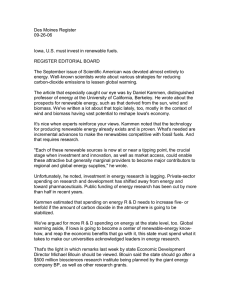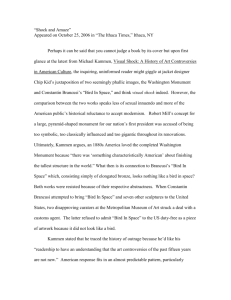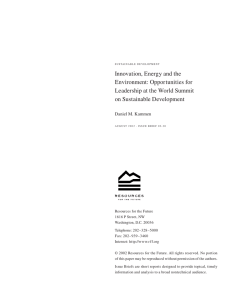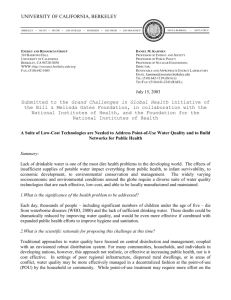ER 100 / 200 and Pub Pol C184 / C284 Energy and Society
advertisement
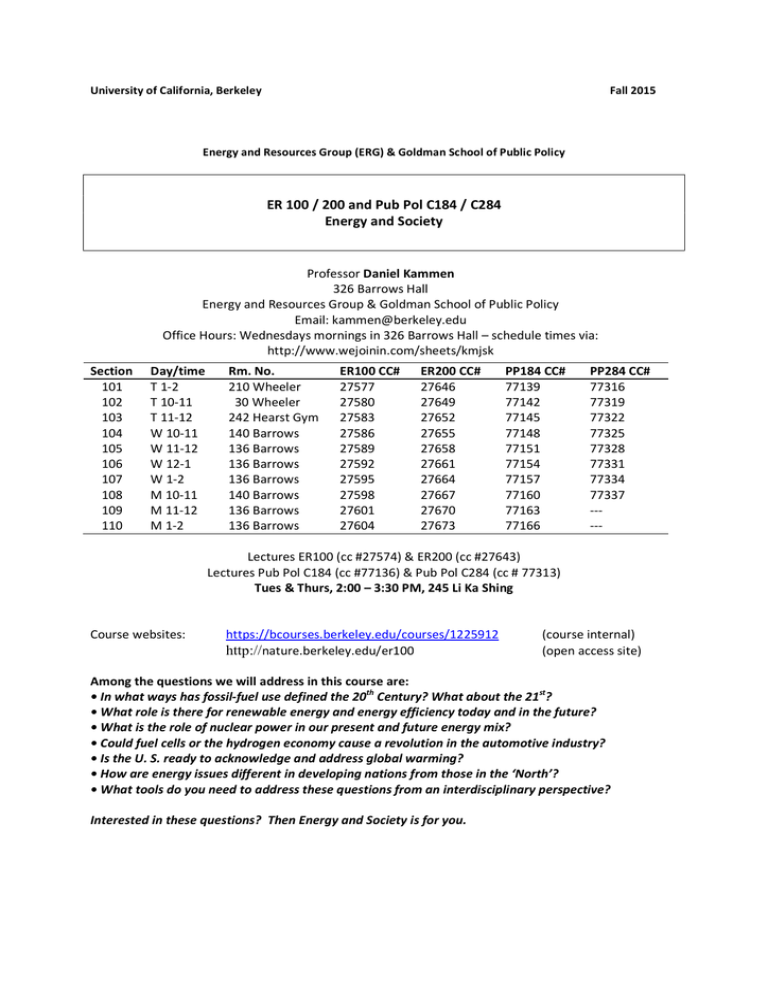
University of California, Berkeley Fall 2015 Energy and Resources Group (ERG) & Goldman School of Public Policy ER 100 / 200 and Pub Pol C184 / C284 Energy and Society Section 101 102 103 104 105 106 107 108 109 110 Professor Daniel Kammen 326 Barrows Hall Energy and Resources Group & Goldman School of Public Policy Email: kammen@berkeley.edu Office Hours: Wednesdays mornings in 326 Barrows Hall – schedule times via: http://www.wejoinin.com/sheets/kmjsk Day/time T 1-2 T 10-11 T 11-12 W 10-11 W 11-12 W 12-1 W 1-2 M 10-11 M 11-12 M 1-2 Course websites: Rm. No. 210 Wheeler 30 Wheeler 242 Hearst Gym 140 Barrows 136 Barrows 136 Barrows 136 Barrows 140 Barrows 136 Barrows 136 Barrows ER100 CC# 27577 27580 27583 27586 27589 27592 27595 27598 27601 27604 ER200 CC# 27646 27649 27652 27655 27658 27661 27664 27667 27670 27673 PP184 CC# 77139 77142 77145 77148 77151 77154 77157 77160 77163 77166 Lectures ER100 (cc #27574) & ER200 (cc #27643) Lectures Pub Pol C184 (cc #77136) & Pub Pol C284 (cc # 77313) Tues & Thurs, 2:00 – 3:30 PM, 245 Li Ka Shing https://bcourses.berkeley.edu/courses/1225912 http://nature.berkeley.edu/er100 PP284 CC# 77316 77319 77322 77325 77328 77331 77334 77337 ----- (course internal) (open access site) Among the questions we will address in this course are: • In what ways has fossil-fuel use defined the 20th Century? What about the 21st? • What role is there for renewable energy and energy efficiency today and in the future? • What is the role of nuclear power in our present and future energy mix? • Could fuel cells or the hydrogen economy cause a revolution in the automotive industry? • Is the U. S. ready to acknowledge and address global warming? • How are energy issues different in developing nations from those in the ‘North’? • What tools do you need to address these questions from an interdisciplinary perspective? Interested in these questions? Then Energy and Society is for you. Energy and Society ER100 & 200 / Pub Pol 184 & 284 – Daniel M.Kammen Page 2 Fall 2015 Each of these questions about the use and impacts of energy systems requires an interdisciplinary understanding that explores the scientific, technical, economic, social, political, and environmental opportunities and impacts of our energy system. In this course, you will develop an understanding—and a technically and socially deep working knowledge—of our energy technologies, policies, and options. This will include analysis of the different opportunities and impacts of energy systems that exist within and between groups defined by national, regional, household, ethnic, and gender distinctions. Analysis of the range of current and future energy choices will be stressed, as well as the role of energy in determining local environmental conditions and the global climate. ER200/GSPP284 are graduate versions of ER100/GSPP184, and their lectures and sections are held in common. ER200/GSPP284 includes additional material, with added analytic tools and problems on both the problem sets and the examinations. Grading for the undergraduate and graduate courses are separate. Undergraduates must enroll in ER100/GSPP184, and graduate students must enroll in ER200/GSPP284. Course Goals This course is designed to provide you with the methods, tools and perspectives to understand, critique, and ultimately influence the management of technical, economic, and policy choices regarding the options for energy generation and use. We will focus equally on the technical, socioeconomic, political, and environmental impacts of energy. We will examine the full ‘life cycle’, or ‘cradle to grave to cradle again’ of energy, from the stage of raw materials, or inputs, to generation, conversion, distribution, consumption, recycling, waste, impacts, and ethnic, racial, gender, and economic inequities. This work is inherently interdisciplinary, and will involve a fascinating but extensive effort to understand, critique, and integrate tools and perspectives from anthropology, cultural and ethnic studies, economics, engineering, physics, politics, sociology, and who knows what else. The challenge of this integration is not simply one of learning and applying methods from very diverse disciplines, but more importantly is one of understanding how and when different types of analysis, disciplinary and political perspectives, and “voices” are heard, unheard, ignored, or discredited. Energy is a fundamental societal resource, the control of which reflects and shapes interactions both within society and between humans and the natural environment. Coverage Over the semester we will take a roughly chronological tour of the major fuel types used in human civilization. From there we will begin a broad-ranging analysis of the energy resource, combustion or conversion processes, application, waste, economic, social, political, cultural, and environmental impacts and options associated with these fuels and with the changing mix of fuels used within and across societies around the globe. Energy and Society ER100 & 200 / Pub Pol 184 & 284 – Daniel M.Kammen Page 3 Fall 2015 Assignments There will be seven problem sets and a policy memo (in total 30% of the grade), a mid-term examination (25%), and a final exam (35%). Participation in sections counts for 10%. Problem sets are distributed every other Tuesday, and due back, in class, the Thursday of the following week. You may also turn the assignment in at the box located in the hallway outside the ERG office (310 Barrows) BEFORE 5pm Thursday. Late assignments will be penalized 20% if turned in by 5pm on Monday, or 50% if turned in by 5pm on the following Thursday. No credit will be given for assignments turned in more than one week late. You will get the most out of the problem sets if you make an initial effort to work through all of the problems on your own. After attempting to solve the problems on your own, you may then work with other students to discuss different approaches. It is vital that you do your own work. It is a violation of the Code of Student Conduct to copy answers from anyone. As part of your participation in the course, you are encouraged to use the bCourses discussion board to make comments and/or ask questions related to the readings or lectures. We will also post the answers to questions about the problem sets on bCourses, so be sure to check bCourses regularly. Required Texts (available at thecampus store on Bancroft) Hirsh, Richard (2000) Power Loss: The Origins of Deregulation and Restructuring in the American Electric Utility System (MIT Press: Cambridge, MA). Rubin, Edward S. (2001) Introduction to Engineering & the Environment (McGraw Hill: New York, NY). Web-based readings: A number of readings, both required and supplemental, are available on-line. In order to download some of these, you will need to use an on-campus computer or set up your home computer or laptop with the campus proxy service. For instructions, see: http://www.lib.berkeley.edu/using-the-libraries/connect-off-campus Readings are also available at the course website and on the course bCourses site. Required Reading assignments should be completed before the lecture for which they are assigned. While I recognize that this is not always possible, you need to try; the material in lecture does not simply review the readings; we use it as a basis for exploration of the course material and ideas. Energy and Society ER100 & 200 / Pub Pol 184 & 284 – Daniel M.Kammen Page 4 Fall 2015 Optional Field Trips There will be several field trips during the semester. Each will be 3 - 6 hours (including travel time), and all will be Friday mornings. The list will depend on availability, but will likely include: The Pittsburgh Energy ‘Park’, a 2200 MW fossil-fuel power plant (gas and oil); California Windfarm FlexLab, LBL SunSet Solar (San Francisco) Graduate Student Instructors and Office Hours John Romankiewicz Fernando CastroAlvarez Jessie Knapstein Julia Sznai Kenji Shiriashi Office: 399 Barrows 399 Barrows 399 Barrows 399 Barrows 399 Barrows Hours: Tues 9-11am Mon 4-6pm Wed 2-4pm Mon 2-4pm Mon 9-11am Email: sustainablejohn @gmail.com fcastroa@berkele y.edu jessie.l.knapstein @gmail.com jszinai@berkeley.ed kenjis@berkeley.e du u Reach us by email or by coming to the office hours. Section meetings begin in Week 2 (i.e. starting 9/1). Be sure to sign up for a section on-line. Lecture Notes Lecture notes (.pdf files) will be available for each lecture, and will be posted on the course website generally a week before the lecture. You should download the files and bring them to lecture so that you have all of the graphs and diagrams right in front of you. Energy and Society ER100 & 200 / Pub Pol 184 & 284 – Daniel M.Kammen Wk 8-27 Lecturer Kammen Lecture #/Topic 2 9-1 Kammen 2. Energy Toolkit I: Units, Forecasts, and the Back-of-the-Envelope 3 9-8 Kammen 4. Energy for ‘the South’ I: Energy Transitions and Development 1 4 5 6 7 Date Page 5 Fall 2015 9-3 9-10 9-15 9-17 9-22 9-24 9-29 10-1 10-6 10-8 Kammen Kammen Kammen Kammen Kammen Kammen Kammen Horvath 9 10-20 GSIs 11 8. ‘Hydrocarbon Man’ 9. Evolution of the Modern Energy Economy 10. Energy Toolkit V: Economic Analysis of Energy Systems 11. Energy Toolkit VI: Life-Cycle and Cost-Benefit Analysis 13. Energy Efficiency II: Buildings and Larger Energy Systems 15. Natural Gas, Fracking, and Carbon Capture and Storage You! Midterm Exam, In class Budnitz 17. Nuclear Energy II: Waste, Risk & Economics Kammen 19. Renewable Energy I: Solar Energy Peterson 11-3 Kammen 11-5 7. Energy Toolkit IV: Thermodynamics of Modern Power Plants Kammen 10-27 10-29 6. Energy Toolkit III: Energy Thermodynamics 14. Electricity Grids: Managing the Network Kammen Callaway 10 5. Energy for ‘the South’ II: Biomass, Households, and Gender 12. Energy Efficiency I: Devices 10-13 10-22 3. Energy Toolkit II: Fuels, Energy Content & Basics of Combustion Kammen 8 10-15 1. How Energy Use Shapes Society & the Environment Mid-term review 16. Nuclear Energy I: Physics and Engineering – Fission/Fusion 18. Energy and Environmental Justice / Designing Policy Memos 12 11-10 Kammen 20. Renewable Energy II: Wind, Geothermal & Hydropower 13 11-18 Kammen 22. Renewable Energy IV: Industrial Bioenergy& Land Use 14 15 11-12 11-20 11-25 11-27 12-1 12-3 Gur Kammen Kammen Kammen Kammen 21. Renewable Energy III: Electrochemistry -H2 Batteries and Fuel Cells 23. International Energy Policy 24. Transportation systems and policies HOLIDAY THANKSGIVING 25. Climate Change I: Energy and Climate 26. Climate Change II: Energy Policy Final Exam Group: 5: TUESDAY, DECEMBER 15, 2015 8-11AM Energy and Society ER100 & 200 / Pub Pol 184 & 284 – Daniel M.Kammen Problem Set # 1 Assigned 9/1 Due 9/10 2 9/15 9/24 4 10/8* 10/15 3 9/29 10/8 5 10/27 11/10 11/19 7 11/24 12/3 6 11/5 Page 6 Fall 2015 Coverage Short warm-up problems; analysis of utility bills; making unit analysis your friend, and getting comfortable with the myriad of energy units. These problems may be unfamiliar in style for many of you; if necessary use the GSI’s and study groups to ‘get into the swing’ of these calculations/estimates. You must, however, do your own work. Energy use at household and national scales; basic thermodynamics; combustion. Thermodynamics of energy systems, combustion of various fuels; comparisons of energy conversion efficiencies, emissions, financial analysis of power plants. Energy economics. Life-cycle analysis; learning curves; energy efficiency, evolution of the modern energy system. [Shorter problem set] Environmental justice; energy efficiency and conservation; the grid; nuclear energy. Nuclear energy and waste, renewable energy systems, fuel cells and hydrogen. Biomass energy, transportation, energy and climate, and climate policy. * Note: non-standard assignment dates (mid-term & thanksgiving). No late assignments accepted for PS #4 so that we can return to you graded problem sets on 10/21, prior to the exam. Problem sets are posted on the web, not physically distributed in class. Do not leave problem sets for the final few days. They are not hard if started early; they can be an unpleasant experience if left for the night before they are due. Problem sets are due in class or can be turned in to the problem set drop-off box outside of the Energy and Resources Group, 310 Barrows Hall. Problem sets are late after 5:00 PM. Problem sets cannot be turned in electronically or by fax. Energy and Society ER100 & 200 / Pub Pol 184 & 284 – Daniel M.Kammen Page 7 Fall 2015 You should be familiar with the readings listed for each lecture date when the lecture occurs occurs—they will be referenced under the assumption that you have read them already. Readings listed for ER200/PP284 are required for graduate students. Readings listed as Supplemental will (perhaps obviously) supplement your understanding of the course material, but are not required to successfully complete the course. Week 1 – Introduction to Energy Systems and Society Lecture 1 (8/27) – Energy and Society: How Energy Use Use Shapes Society & the Environment Environment: Recommendation:: Try getting into the habit of looking for energy articles in newspapers and begin to get a feel for how ubiquitous and far-reaching far reaching energy issues are in society. In addition, check the opinion (“OpEd”) and editorial pages of your favorite newspapers. As your last assignment of the course, you will be writing a ‘policy memo’ that in most cases can and should be submitted as an Op Ed yourself Yergin, D. (1991) The Prize: The Epic Quest for Oil, Money, and and Power (Simon & Schuster: New York). Pages 11 – 16.[ Yergin_1991.pdf] Plus, read a selection – you decide how many -- of these energy-related op-eds eds or others you look up (a good habit). Read these ‘classic’ energy op eds: eds Tim Flannery – The New York Times “A ‘Third Way’ to Fight Climate Change” http://www.nytimes.com/2015/07/24/opinion/a http://www.nytimes.com/2015/07/24/opinion/a-third-way-to-fight-climate-change.html change.html July 23, 2015 Ralph Cavanagh nagh (2013) “How we learned not to guzzle” (9/12/13) guzzle.html?_r=0 http://www.nytimes.com/2013/09/13/opinion/how http://www.nytimes.com/2013/09/13/opinion/how-we-learned-not-to-guzzle.html?_r=0 Ban Ki-Moon Moon (2012) “Powering sustainable energy for all” (1/11/12) all.html http://www.nytimes.com/2012/01/12/opinion/powering http://www.nytimes.com/2012/01/12/opinion/powering-sustainable-energy-for-all.html Kirk Smith (2014) “In praise of power” (8/8/14) 47b9-a8dc-3419985a8a3b http://www.sciencemag.org/content/345/6197/603.full.pdf?sid=1593517d http://www.sciencemag.org/content/345/6197/603.full.pdf?sid=1593517d-66d6-47b9 Doerr, J. and Immlet, J. (2009) “Falling behind on green tech”, The Washington Post (8/3/09) http://www.washingtonpost.com/wp dyn/content/article/2009/08/02/AR2009080201563.html http://www.washingtonpost.com/wp-dyn/content/article/2009/08/02/AR2009080201563.html For a feed of (hopefully) interesting energy news, see Twitte Twitter: @dan_kammen Energy and Society ER100 & 200 / Pub Pol 184 & 284 – Daniel M.Kammen Week 2 – Methods in Energy Analysis Page 8 Fall 2015 Lecture 2 (9/1) – Energy Toolkit I: Units, Forecasts, and the Back-of-the-Envelope: Back : Rubin, EE, Rates of Technology Adoption, Adoption Pages 669 – 677. Lovins, Amory (1976) “Energy Strategy: The Road Not Taken”, Foreign Affairs, 55(1): 65–96. [ Lovins_1976.pdf] ER200 & Pub Pol 284: A nice commentary on the Lovins paper from The New York Times: http://www.nytimes.com/2008/10/07/science/07tier.html?_r=1&8dpc&oref=slogin Supplemental: Toolkit 1 (a review and refresher) – optional/reference for those who have done these sorts of problems before. A bit more than back of the envelope, applied to scaling-up scaling technologies: http://www.gigatonthrowdown.org/ Lecture 3 (9/3) – Energy Toolkit II: Fuels, Energy Content, and Basics of Combustion: Combustion Rubin, EE, Chapter 1, pages 3 – 17. Masters, G. (1991) Introduction to Environmental Engineering and Science (Prentice Hall: NJ), pages 39– 39 47. [ Masters_1991_Enviro_Chemistry.pdf] Supplemental: Toolkit 2 (resource material) Page 9 Fall 2015 Energy and Society ER100 & 200 / Pub Pol 184 & 284 – Daniel M.Kammen Week 3 – Energy and Development Lecture 4 (9/8) – Energy for ‘the South’ I: Energy Transitions and Development Development: Goldemberg, J. (1996) Energy, Environment, and Development (Earthscan: London, UK), 11 – 37. [ Goldemberg_1996.pdf] Jacobson, A. and D.M. Kammen. (2005). “Science and Engineering Research that Values the Planet.” The Bridge. 35(4): pp. 11-17. 17. [ Jacobson_2005.pdf] ER200/PP284: Alstone, P., Gershenson, D. and Kammen, D. M. (2015) “Decentralized “Decentralized energy systems for clean electricity access“, Nature Climate Change, Change 5, 305 – 314. Lecture 5 (9/10) – Energy for ‘the South’ II: Biomass, Households, and Gender: Kammen, D. M. and Dove, M. R. (1997) “The virtues of mundane science”, Environment, Environment 39(6): 10–15, 38–41. [ Kammen_1997.pdf] Kammen_1997 Sovacool, B (2014) “Energy studies need social science,” Nature, 511, 529 – 530. Kammen, D. M. (1995) “Cookstoves for the developing world,” Scientific American, American 273, 72 - 75. [ Kammen_1995.pdf] ER200/PP284 Crewe, E. (1997) “The silent traditions of developing cooks”, Discourses of Development, Development R. D. Grillo and R. L. Stirrat, eds. (Berg: Oxford, UK), 59–81. 59 [ Crewe_1997.pdf] Bose, S. (1993) “Women, Work, and Household Electrification in Rural India”, in Money, Energy and Welfare (Oxford University Press: Bombay, India), Chapter V, pages 143 – 181. [ Note: this is a challenging reading. Bose_1993.pdf]. Supplemental: Bailis, Ezzati, Kammen, (2005) “Mortality and Greenhouse Gas Impacts of Biomass and Petroleum Energy Futures in Africa” Science, 308 (5718): p. 98-103. [ Bailis_2005.pdf] Energy and Society ER100 & 200 / Pub Pol 184 & 284 – Daniel M.Kammen Page 10 Fall 2015 Week 4 – Thermodynamics of Energy Lecture 6 (9/15) – Energy Toolkit III: Energy Thermodynamics: Thermodynamics Masters, G. (1991) Introduction to Environmental Engineering and Science (Prentice Hall: NJ), pages 15 – 29. [ Masters_1991_Energy.pdf] Lecture 7 (9/17) – Energy Toolkit IV: Thermodynamics of Modern Power Plants: Plants Rubin, EE, Sections 5.1 - 5.6.3 (except 5.2.2 & 5.2.3); Pages 162 – 175, 179 – 215 Masters, G. (1991) Introduction to Environmental Engineering and Science (Prentice Hall: NJ), pages 327– 327 339. [ Masters_1991_Air_Polluti Masters_1991_Air_Pollution.pdf] ER200 & Pub Pol 284: Dirty Coal, Clean Future, The Atlantic Monthly (November 2010) http://www.theatlantic.com/magazine/archive/2010/12/dirty http://www.theatlantic.com/magazine/archive/2010/12/dirty-coal-clean-future/8307/ future/8307/ Supplemental: Beér, J. M. (2000) “Combustion technology developments in power generation in response to environmental challenges”, Progress in Energy and Combustion Science, Science 26, 301 – 327. [ Beer_2000.pdf] .pdf][An advanced treatment of state-of-the-art fossil art fossil-fuel power plant design issues and opportunities]. Energy and Society ER100 & 200 / Pub Pol 184 & 284 – Daniel M.Kammen Lecture 8 (9/22) – Hydrocarbon Man: Man Week 5 – ‘Hydrocarbon man’ Page 11 Fall 2015 Friedman, Thomas L. (2006) “The First Law of Petropolitics”, Foreign Policy, 154: (28 – 36). [ Friedman_2006.pdf] Farrell, Alex E., and Brandt, Adam R. (2006) “Risks of the oil transition,” Environmental Research Letters, 1, October 30. [ Farrell_2006_Risks Farrell_2006_Risks.pdf] ER200/PP284 (Supplemental for ER100/Pub Pol 184) Nef, John U. (1977) “An early energy crisis and its consequences”, Scientific American, American November, pages 140 – 151. [ Nef_1977.pdf] Lecture 9 (9/24) – Evolution of the Modern Energy Economy: Hirsh, Richard (1999) Power Loss (MIT University Press: Cambridge, MA) Section I, Pages 1 - 88. Energy and Society ER100 & 200 / Pub Pol 184 & 284 – Daniel M.Kammen Week 6 – Energy Economics and Life-Cycle Methods Page 12 Fall 2015 Lecture 10 (9/29) – Energy Toolkit V: Economic Analysis of Energy Systems Systems: Rubin, EE,, Chapter 13, Pages 545 – 577 ER200/PP284: Arrow, K. et al.,, (2013) “Determining the benefits and costs for future generations,” Science, 341, 349 – 350.[ Arrow_2013.pdf] .pdf] Lecture 10 (10/1) – Energy Toolkit VI: Life-cycle and Cost-Benefit Analysis: Rubin, EE,Section 13.4, Life-cycle cycle cost, 556 – 562. ER200/PP284 [Supplemental Supplemental for ER100/PP184]: Jones, C. M. and Kammen, D. M. (2014) “Spatial “Spatial distribution of U.S. carbon footprints reveals suburbanization offsets benefits of population density”, Environmental Science and Technology, Technology 48 (2), 895 – 902. Page 13 Fall 2015 Energy and Society ER100 & 200 / Pub Pol 184 & 284 – Daniel M.Kammen Week 7 – Energy Efficiency (I & II) Lecture 12 (10/6) – Energy Efficiency I: Devices: Rubin, EE,, Chapter 7, and Section 13.8 of Chapter 13, Pages 281 – 314, 577 – 583. Hirsh, Richard (1999) Power Loss (MIT University Press: Cambridge, MA), pages 90 – 117. ER200/PP284: Attari, S. Z. DeKay, M. L. Davidson, Davidson C. I. and Bruine de Bruin, W. (2010) “Public perceptions of energy consumptionand savings”, PNAS, 2010. [ Attari_2010.pdf] Lecture 13 (10/8) – Energy Efficiency II: Buildings as Energy Systems David B. Goldstein (2008) Extreme Efficiency: How Far Can We Go If We Really Need To? ACEEE Summer Study Paper.[ Goldstein_2008.pdf] Goldstein_2008 And for a look at why it is so hard, ask Dilbert: Adams, S. (2010) “How I (Almost) Saved the Earth”, The Wall Street Journal,, August 21: http://online.wsj.com/article/SB10001424052748704868604575433620189923744.html A. Nagourney, et al. (2015) “California California drought tests history of endless growth growth,” The New York Times http://www.nytimes.com/2015/04/05/us/california http://www.nytimes.com/2015/04/05/us/california-drought-tests-history-of-endless dlessgrowth.html?smid=tw-share&_r=0 share&_r=0 Page 14 Fall 2015 Energy and Society ER100 & 200 / Pub Pol 184 & 284 – Daniel M.Kammen Week 8 – Buildings as Energy Systems Lecture 14 (10/13) – Electricity Grids: Managing the Network Network: Masters, G. (2004) “Transmission and Distribution,” in Renewable and Efficient Power Systems (Wiley InterScience: New York), pages 145 – 151. [ Masters_2004_TD.pdf] von Meier, Alexandra (2006), “Reliability” and “Security,” in Electric Power Systems: a conceptual introduction (John Wiley & Sons: New Jersey),pp. 229 229–234.[ von_Meier_2006 von_Meier_2006.pdf] ER200/PP284: Fairley, P. (2004) “The unruly power grid”, IEEE Spectrum,, 13 August, 5 pages. [ Fairley_2004.pdf] Reference: Glossary of electricity terms. [ Electricity_Glossary.pdf] Lecture 15 (10/15) – Natural Gas, Fracking, and Carbon Capture and Storage Brandt, A. et.al.,, (2014) “Methane Leaks from North American Natural Gas Systems” Science, 343(6172), 733-735. Deborah Sontag And Robert Gebeloff (2014) The downside of the boom” The New York Times, 22 November, boom-downside.html http://www.nytimes.com/interactive/2014/11/23/us/north http://www.nytimes.com/interactive/2014/11/23/us/north-dakota-oil-boom Aisch, Gregor (2014) “What North Dakota Would Look Like if Its Oil Drilling Lines Were Above ground”The New York Times, Times November 25 http://www.nytimes.com/interactive/2014/11/24/upshot/nd http://www.nytimes.com/interactive/2014/11/24/upshot/nd-oil-well illustration.html?_r=0&abt=0002&abg=1 ER200 & Pub Pol 184 MIT CCS roadmap - http://web.mit.edu/coal/ Chapters 2 and 3 (pages 5 – 42) Energy and Society ER100 & 200 / Pub Pol 184 & 284 – Daniel M.Kammen Week 9 – Mid-Term Review &Exam Page 15 Fall 2015 Class (10/20) – Midterm examination review Your notes, lecture slides, section handouts, past problem sets and solutions, all previous readings. Class (10/22) – Midterm examination Your notes, lecture slides, section handouts, past problem sets and solutions, all previous readings. Page 16 Fall 2015 Energy and Society ER100 & 200 / Pub Pol 184 & 284 – Daniel M.Kammen Week 10 –Nuclear Power Lecture 16 (10/27) – Nuclear Energy I: Physics and Engineering – Fission/Fusion: Deutch and Lester, (2004) Making Technology Work, Ch. 7: Nuclear Power and Its Fuel Cycle, Cambridge Univ. Press, Cambridge, UK, p. 109-133. 109 [ Deutch_2004.pdf] Moore, P. (2005) “Greenpeace founder makes the case for nuclear power”, Nuclear News, News June, p. 15. . [ Moore_2005.pdf] Supplemental: Excellent online material on reactor types and performance is available at http://www.nrc.gov/reactors/power.html In particular, review ‘About the NRC’, ‘Nuclear security’, and read about the events (power (po production and management) at one of the featured reactors, such as Diablo Canyon (under nuclear reactors) that provides power to northern California) Lecture 17 (10/29) – Nuclear Energy II: Waste, Risk & Economics: Rubin, EE, pages 63-68, 175-178. 178. Flynn, J. et al. (1997) “Overcoming Tunnel Vision: Redirecting the U.S. High-Level High Level Nuclear waste program”, Environment,, 39 (3): 6–11, 25–30. . [ Flynn_1997.pdf] Hultman, N., Koomey, J. G, and Kammen, D. M. (2007) “What history can tell us about the costs of future nuclear power”, Environmental Science & Technology, 41(7): 2088-2093. 2093. . [ Hultman_2007.pdf] The Nuclear Fuel Cycle Cost Calculator: http://thebulletin.org/nuclear-fuel fuel-cycle-cost-calculator ER200/PP284: Peterson, P., W. Kastenberg, and M. Corradini. (2006). “Nuclear Waste and the Distant Future.” Issues in Science and Technology. Technology Summer: pp. 47-50. . [ Peterson_2006.pdf] Peterson_2006 Energy and Society ER100 & 200 / Pub Pol 184 & 284 – Daniel M.Kammen Week 11 – Energy and Environmental vironmental Justice & Renewables Page 17 Fall 2015 Lecture 18 (11/3) – Energy and Environmental Justice: Pastor, Manuel, (2007) “Environmental Justice: Reflections from the United States”, Ch. 14 in Reclaiming Nature, pp. 351–376.[ Pastor_2007 Pastor_2007.pdf] "Climate Change, Consumerism and the Pope with Prof. Daniel Kammen and Governor Jennifer Granholm -- In The Living Room with Henry E. Brady -- UC Public Policy Channel" http://www.uctv.tv/shows/29853 s/29853 Islamic Call on Climate Change http://america.aljazeera.com/articles/2015/8/18/islamic http://america.aljazeera.com/articles/2015/8/18/islamic-scholars-issue-climate-changedeclaration.html ER200/PP284: O’Rourke, D. and Connolly, S. (2003) “Just oil? The distribution of environmental and social impacts of oil nnual Reviews of Environment and Resources, production and consumption,” consumption Annual Resources 28, 587-617. [ Orourke_2003.pdf] An Environmental Justice Resource: A sampling of EJ websites includes: Contents The EJ Information Page http://eelink.net/EJ/ URL Climate Justice and People of Color http://www.ejrc.cau.edu/climatechgpoc.html EJ Case Studies http://www.umich.edu/%7Esnre492/cases.html Ken Saro-Wiwa Wiwa and Shell Oil (Nigeria) (Nigeri http://uk.oneworld.net/guides/nigeria/development Center for Science and Environment (India) http://www.cseindia.org/ EPA Toxic Release Inventory EPA Environmental nmental Justice Program http://www.scorecard.org/ http://www.epa.gov/tri/&http://www.scorecard.org/ http://www.epa.gov/compliance/environmentaljustice http://www.calepa.ca.gov/EnvJustice/ /index.html&http://www.calepa.ca.gov/EnvJustice/ Lecture 19 (11/5) – Renewable Energy I: Solar and Wind Energy: SunShot Vision Study:Read the Executive Summary; Chapter 4, Photovoltaics: Technology, Cost, and Performance; and ; chapter[ chapter vision-study Solar_Vision_Study_2010 Solar_Vision_Study_2010.pdf]http://energy.gov/eere/sunshot/sunshot-vision Masters, G. (2004) “Photovoltaic taic Materials and Electrical Characteristics.” Renewable and Efficient Power Systems (Wiley InterScience: New York), pages 445 – 463.[ ER200/PP284: Masters_2004_PV.pdf] Energy and Society ER100 & 200 / Pub Pol 184 & 284 – Daniel M.Kammen Page 18 Fall 2015 Zheng, Cheng and Kammen, Daniel (2014) “An Innovation-Focused Roadmap for a Sustainable Global Photovoltaic Industry,” Energy Policy, 67, 159–169. Energy and Society ER100 & 200 / Pub Pol 184 & 284 – Daniel M.Kammen Week 12 – Renewable Energy II: Wind and Water Powerr Page 19 Fall 2015 Lecture 20 (11/10) – Renewable Energy II: Wind, Hydropower and Geothermal Energy Masters, G. (2004) “Wind Power Systems.” Renewable and Efficient Power Systems (Wiley InterScience: New York), pages 307 – 354 (pages 335-347 are supplemental), 371 – 378. [ Masters_2004_Wind.pdf] Hydropower reading TBD Lecture 21 (11/12) – Renewable Energy III:Electrochemistry I H2 Batteries and Fuel Cells Masters, G. (2004) “Fuel Cells,” in Renewable and Efficient Power Systems (Wiley InterScience: New York), pages 206-228. [ Masters_2004_Fuel_Cells.pdf] 94-101. [ Ogden, J. (2006). “High Hopes for Hydrogen”, Scientific American, September, pp. 94 Ogden_2006.pdf] ER200/PP284: Keith, D. W. and Farrell, A. E. (2003) “Rethinking hydrogen cars”, Science, 301,, 315 – 316. [ Keith_2003.pdf] Energy and Society ER100 & 200 / Pub Pol 184 & 284 – Daniel M.Kammen Page 20 Fall 2015 Week 13 – Energy and Sustainability Challenges Lecture 21 (11/17) – Renewable Energy IV: Industrial Bioenergy and Land Use http://feedstockreview.ornl.gov/pdf/billion_ton_vision.pdf) USDA - Billion Ton Vision (http://feedstockreview.ornl.gov/pdf/billion_ton_vision.pdf http://feedstockreview.ornl.gov/pdf/billion_ton_vision.pdf Rubin, EE, Chapter 3, Pages 83-123. 123. ER200/PP284:: Farrell A. E., Plevin, R. J. Turner, B. T., Jones, A. D. O’Hare, M. and Kammen, D. M. (2006) “Ethanol can contribute to energy and environmental goals,” Science, 311, 311 506 – 508. [ Farrell_2006_Ethanol.pdf] Supplemental:Intergovernmental Intergovernmental Panel on Climate Change, Special Report on Renewable Energy Sources and Climate Change Mitigation, http://srren.ipcc-wg3.de/,, Chapter 2, “Bioenergy”, 209332. Lecture 22 (11/19) – International Energy Policy Intergovernmental Panel on Climate Change, Special Report on Renewable Energy Sources and Climate Change Mitigation, http://srren.ipcc-wg3.de/, http://srren.ipcc Chapter 11, “Policy, Financing, and Implementation”, 882 – 916 (all), 917 – 928 (ER200). World Energy Council (2011) Policies for the future, 2011 Assessment of country energy and climate policies. Skim the initial chapters after you review the energy policy metric (Chapter 1), and specifically read pages, 48 – 63. http://www.worldenergy.org/documents/wec_2011_assessment_of_energy_and_climate_policies.pdf Energy and Society ER100 & 200 / Pub Pol 184 & 284 – Daniel M.Kammen Page 21 Fall 2015 Week 14 – Transportation Systems Lecture 23 (11/24) – Transportation systems and policy: policy Service, R. (2013) “Battle for the barrel”, Science, 339, 1374 – 1379. Sager, J., Lemoine, D, Apte, J. and Kammen, D. M. (2011) (201 “Reduce Reduce growth rate of light duty vehicle travel to meet 2050 global climate goals.” Environmental Research Letters, 6(2), (2), 024018. 024018.[ Sager_etal_2011.pdf] ER200 & Pub Pol 284: Jones, C. M. and Kammen, D. M. (2014) “Spatial “Spatial distribution of U.S. carbon footprints reveals suburbanization offsets benefits of population density”, Environmental Science and Technology, Technology 48 (2), 895 – 902. Supplemental: Schewel, L., & Schipper, L. (2011). Fossil Freight: How Much Fossil Fuel Does It Take to Move Fossil 1281). Fuel?. In Transportation Research Board 90th Annual Meeting (No. 11-1281). Bürer, Mary J., et al. (2004) “Location Efficiency as the Missing Piece of The Energy Puzzle: How Smart Growth Can Unlock Trillion Dollar Consumer Cost Savings.” Natural Resources Defense Council and Sierra Club. [ Burer_2004 Burer_2004.pdf] No Lecture on (11/26) – Academic Holiday. Energy and Society ER100 & 200 / Pub Pol 184 & 284 – Daniel M.Kammen Week 15 – Energy and the Global Environment Page 22 Fall 2015 Lecture 24 (12/1) – Climate Change I: Energy and Climate: Climate Rubin, EE,, Chapter 12, Pages 470 – 537. Hansen, J., Sato, M. and Ruedy, R. (2012) “Perception of climate change”, PNAS,, [ Hansen_etal_2012.pdf] Collins, William, et al. (2007) “The Physical Science Behind Climate Change.” Scientific American. August, 297, pp 64–71. [ Collins_2007.pdf] Need a replacement (IPCC?) Supplemental: Emanuel,Kerry (2005), “Increasing destructiveness of tropical cyclones over the past 30 years.” Nature, 436:: 686–688, 686 August 4. [ Emanuel_2005.pdf] Lecture 25 (12/3) – Climate Change II: Energy Policy: Policy Pacala, S., and Socolow, R. (2004) “Stabilization wedges: solving the climate problem for the next fifty years with current technologies”, Science, 305, 968 – 971. [ Pacala_2004 Pacala_2004.pdf] (5488): 2287. [ Baer, P., et al. (2000). “Equity and Greenhouse Gas Responsibility.” Science289(5488): Baer_2000.pdf] David J Frameand Cameron Hepburn (2010) “An An issue of trust: state corruption, responsibility and 9326/5/1/014004 greenhouse gas emissions”, emissions”,Environ. Res. Lett.5 (2010), doi:10.1088/1748-9326/5/1/014004 Steffen, W. et al. (2015) “Planetary Planetary boundaries: Guiding human development on a changing planet”Science, 347 Supplemental: Online resource: C-ROAD maker-oriented-uclimatehttp://climateinteractive.wordpress.com/2008/09/19/pangaea http://climateinteractive.wordpress.com/2008/09/19/pangaea-our-decision-maker simulator/ Sailor, W. C., Bodansky, D., Braun, C. Fetter, S. and van der Zwaan, R. (2000) “A nuclear solution to climate change”, Science, Science 288 (5469), 1177–1178. [ Sailor_2000.pdf] Kammen, D.M. and Nemet, G.F. (2005). “Reversing the Incredible Shrinking Energy R&D Budget.” Issues in Science and Technology. Fall: pp. 84-88.
